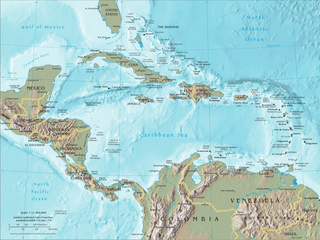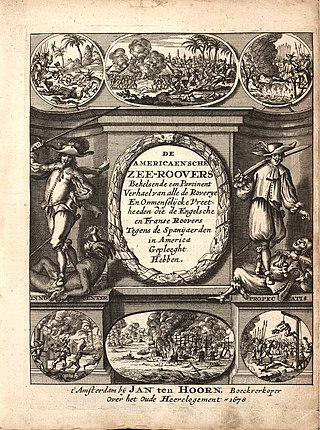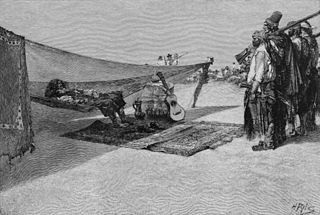See also 1696 in piracy, other events in 1697, 1698 in piracy and Timeline of piracy.
See also 1696 in piracy, other events in 1697, 1698 in piracy and Timeline of piracy.
| | This section is empty. You can help by adding to it. (July 2010) |

Buccaneers were a kind of privateer or free sailors particular to the Caribbean Sea during the 17th and 18th centuries. First established on northern Hispaniola as early as 1625, their heyday was from the Restoration in 1660 until about 1688, during a time when governments in the Caribbean area were not strong enough to suppress them.

The era of piracy in the Caribbean began in the 1500s and phased out in the 1830s after the navies of the nations of Western Europe and North America with colonies in the Caribbean began hunting and prosecuting pirates. The period during which pirates were most successful was from the 1660s to the 1730s. Piracy flourished in the Caribbean because of the existence of pirate seaports such as Port Royal in Jamaica, Tortuga in Haiti, and Nassau in the Bahamas. Piracy in the Caribbean was part of a larger historical phenomenon of piracy, as it existed close to major trade and exploration routes in almost all the five oceans.

Tortuga Island is a Caribbean island that forms part of Haiti, off the northwest coast of Hispaniola. It constitutes the commune of Île de la Tortue in the Port-de-Paix arrondissement of the Nord-Ouest department of Haiti.

Alexandre Olivier Exquemelin was a French, Dutch, or Flemish writer best known as the author of one of the most important sourcebooks of 17th-century piracy, first published in Dutch as De Americaensche Zee-Roovers, in Amsterdam, by Jan ten Hoorn, in 1678.

Thomas Tew, also known as the Rhode Island Pirate, was a 17th-century English privateer-turned-pirate. He embarked on two major pirate voyages and met a bloody death on the second, and he pioneered the route which became known as the Pirate Round. Other infamous pirates in his path included Henry Avery and William Kidd.
This timeline of the history of piracy in the 1680s is a chronological list of key events involving pirates between 1680 and 1689.

The Golden Age of Piracy is a common designation for the period between the 1650s and the 1730s, when maritime piracy was a significant factor in the histories of the North Atlantic and Indian Oceans.

Bartholomew Sharp was an English buccaneer and privateer. His career of piracy lasted seven years (1675–1682). In the Caribbean he took several ships, and raided the Gulf of Honduras and Portobelo. He took command of an expedition into the Pacific and spent months raiding settlements on the Pacific Coast of South America including La Serena which he torched in 1680. His flagship, taken at Panama, was the Trinity.

Edward Davis or Davies was an English buccaneer active in the Caribbean during the 1680s and would lead successful raids against Leon and Panama in 1685, the latter considered one of the last major buccaneer raids against a Spanish stronghold. Much of his career was later recorded by writer William Dampier in A New Voyage Round the World (1697).

The Brethren or Brethren of the Coast were a loose coalition of pirates and buccaneers that were active in the seventeenth and eighteenth centuries in the Atlantic Ocean, Caribbean Sea, and Gulf of Mexico. They mostly operated in two locations, the island of Tortuga off the coast of Haiti and in the city of Port Royal on the island of Jamaica.
This timeline of the history of piracy in the 1660s is a chronological list of key events involving pirates between 1660 and 1669.
This timeline of the history of piracy in the 1650s is a chronological list of key events involving pirates between 1650 and 1659.
Captain John Coxon, sometimes referred to as John Coxen, was a late-seventeenth-century buccaneer who terrorized the Spanish Main. Coxon was one of the most famous of the Brethren of the Coast, a loose consortium of pirates and privateers. Coxon lived during the Buccaneering Age of Piracy.

The Capture of Fort Rocher took place on 9 February 1654, during the Franco-Spanish War (1635–1659). Equipped with one siege battery, a Spanish expedition of 700 troops attacked the buccaneer stronghold of Tortuga, capturing the Fort de Rocher and 500 prisoners including 330 buccaneers and goods valued at approximately 160,000 pieces-of-eight. The Spanish burned the colony to the ground and slaughtered its inhabitants, leaving behind a fort manned by 150 soldiers. They possessed the island for about eighteen months, but on the approach of the expedition under Penn and Venables were ordered by the Conde de Peñalva, Governor of Santo Domingo, to demolish the fortifications, bury the artillery and other arms, and retire to his aid in Hispaniola.

Between 1665 and 1857, Caribbean pirates and filibusters operated in Lake Nicaragua and the surrounding shores. The Spanish city of Granada, located on the lake, was an important trading centre for much of its early history so it was a prime target for pirates such as Welshman Henry Morgan and freebooters like William Walker.

The Atlantic World refers to the period between European colonisation of the Americas (1492-) and the early nineteenth century. Piracy became prevalent in this era because of the difficulty of policing this vast area, the limited state control over many parts of the coast and the competition between different European powers. The best known pirates of this era are the Golden Age pirates (c.1650-1730) who roamed the seas off the coast of North America, Africa and the Caribbean.

The Sack of Campeche was a 1663 raid by pirates led by Christopher Myngs and Edward Mansvelt which became a model for later coastal pirate raids of the buccaneering era.
George Spurre was an English pirate and buccaneer. He is best known for sacking Campeche and for joining a large buccaneer force which captured Veracruz.

Acts of grace, in the context of piracy, were state proclamations offering pardons for acts of piracy. General pardons for piracy were offered on numerous occasions and by multiple states, for instance by the Kingdom of England and its successor, the Kingdom of Great Britain, in the 17th and 18th centuries.